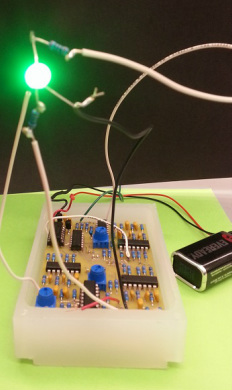
This project focused on building a circuit to match itself to whatever color that it was place on, "camouflaging" the device. Working with a team of three other students, I helped to design a circuit that measure the color of a surface through splitting it into an RGB color signal and then reproducing it with an three color RGB LED. As is visible in the picture to the left, the circuit could successfully reproduce the color of its surroundings. This was also tested on many different colors and reproduced them all, with varying margins of success. The circuit diagram is shown below and there is also a linked copy of the report produced.
The system worked through using LEDs to bounce three colors of light off of a surface, and then measured the amplitude of the reflected signal. This signal was then filtered and buffered and sent to an RGB LED. The three signals were combined through the color mixing properties of the LED and then further diluted through a translucent polypropylene casing. The casing improved the look and finish of the product, as well as providing further mixing of the three signals.
The system worked through using LEDs to bounce three colors of light off of a surface, and then measured the amplitude of the reflected signal. This signal was then filtered and buffered and sent to an RGB LED. The three signals were combined through the color mixing properties of the LED and then further diluted through a translucent polypropylene casing. The casing improved the look and finish of the product, as well as providing further mixing of the three signals.